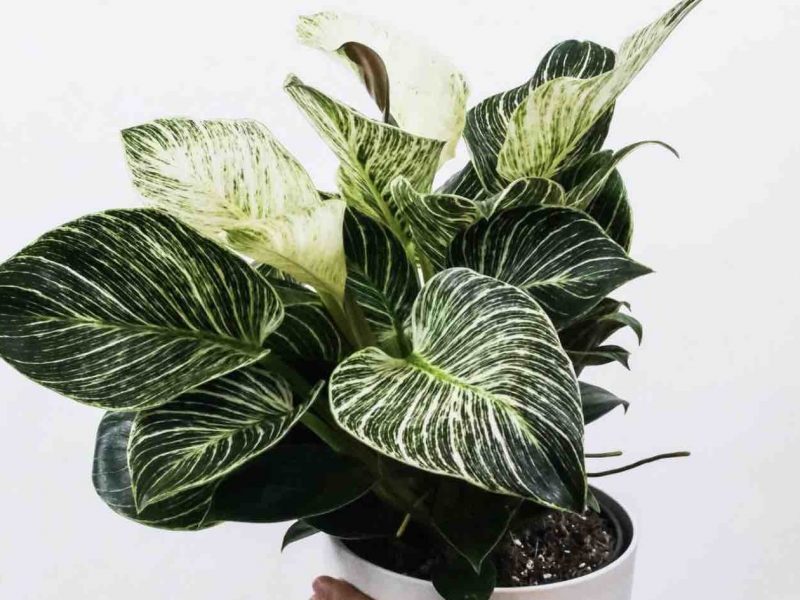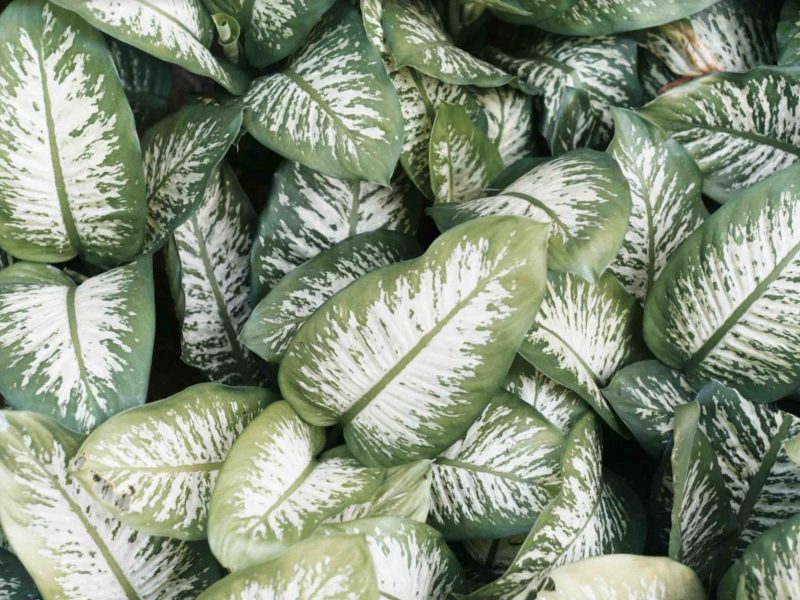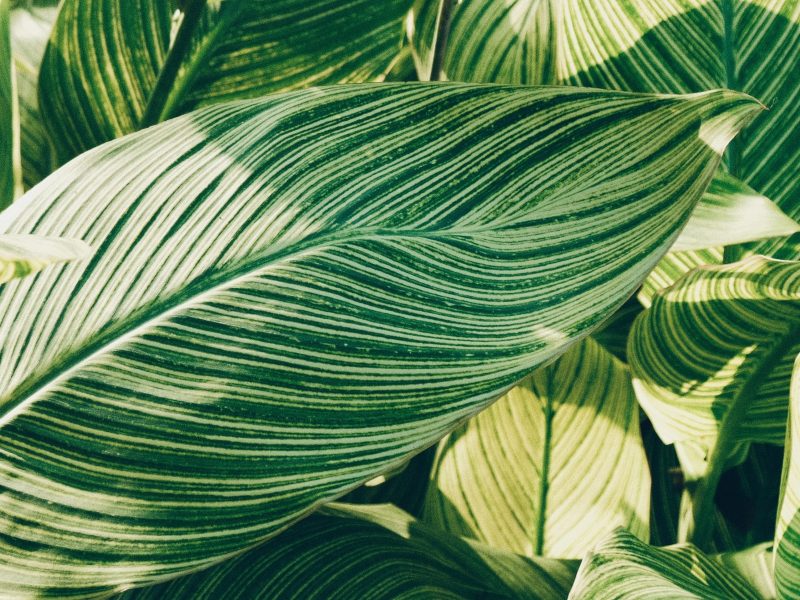
The once-rare Philodendron Birkin is starting to pop up in plant shops across the world. They are easy to care for so are perfect for inexperienced plant parents and their incredible green and white striped leaves bring something a little different to your home.
One of the reasons that they have become so popular is because of their unique foliage. Loved
for their deep green and white pinstripe leaves, no two leaves are the same which makes this an incredible plant. In terms of flowering, it’s pretty rare to find a flower on a Philodendron Birkin and even when you do, they aren’t super aesthetic and it’s often best to remove them from the plant to save energy.
The Philodendron Birkin is also one of the plant types that are genetically unstable. This means that the leaves it produces can look wildly different from each other. You might occasionally get a leaf that is entirely white or entirely green. It’s even known to have a splash of pink in there every now and again if you’re lucky!
How to care for a Philodendron Birkin
One of the best things about the Philodendron Birkin is that they have quite an easy care routine and can adapt to a range of different environments.
Although they thrive best in bright but indirect light, they can adapt to lower-light environments. The only thing to note here is that growth will be slower and you may see that new leaves are more solid green and have lost some of that variegation.
The watering technique is pretty much the only challenge about caring for these plants as they like a moist but not soggy potting mix. Go for a little but often watering approach to avoid extremes and monitor the soil to know when it’s time for more water.
Not only are they relatively easy to care for, but they are quite compact and won’t outgrow the space that quickly. So whether you don’t have the best track record at keeping plants alive, or if you don’t have much space, the Philodendron Birkin is still a great choice!
Origin: Tropical rainforests of Central and South America
Latin Name: Philodendron Birkin
Common Name(s): Philodendron Birkin, Philodendron White Wave or ‘Birkin White Wave
Plant Family: Araceae
Difficulty Level: Medium
Appearance: Unique dark green leaves with creamy white streaks and stripes throughout.
Height and Size: Mature height of 3 feet (0.9 meters)
Growth Rate: Medium
Flowering: Rare but can occasionally grow small white flowers.
Pruning: Regular pruning not required. Only to remove dead or dying leaves.
Cleaning: Dust every 2-4 weeks.
Light Requirements: Bright, indirect sunlight.
Water Requirements: Moist but not soggy potting mix.
Best Soil: Well-draining, high-quality and nutrient-rich.
Ideal temperature: 55-85°F (13-29°C)
Fertilizing Routine: Apply a well-balanced 10-10-10 fertilizer twice a month in spring and summer.
Ideal Humidity Level: 50-60% humidity.
Propagation: Through stem cuttings
Repotting Frequency: On average, repot every 1 to 2 years.
Toxicity: Toxic to pets and humans if ingested.
Risk of Pests: Risk of spider mites, thrips, scale insects and mealybugs
Common Problems: Discolouration of the leaves (yellow or brown), leaf drop and curling leaves.
Origin and Family of a Philodendron Birkin
As you’ll know from the name, Birkins are part of the Araceae family within the Philodendron genus which was first discovered in Brazil. Native to tropical and humid climates, there are nearly 500 different varieties of Philodendron, all with their unique qualities and appearances.
However, the Philodendron Birkin differs from the rest of its family as it doesn’t actually grow in the wilderness but was created from a rare mutation when the Philodendron Rojo Congo was being cultivated.
Because the plant stemmed from this rare occurrence, at first Birkins were impossible to find and when you could, the prices were enormous for a little cutting. However, now the plant is being mass-produced and is quite commonly available and affordable.
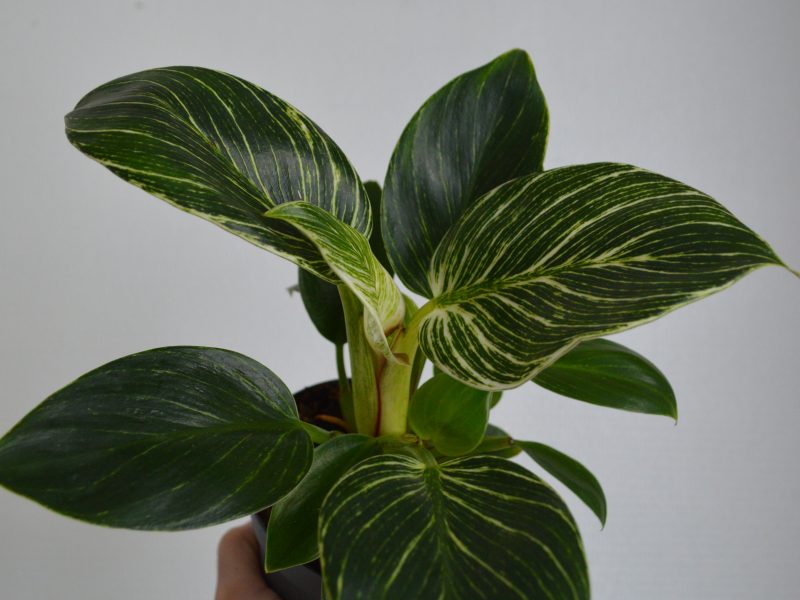
Philodendron Birkin Appearance
Known for its unique creamy white and green variegated foliage, the Philodendron Birkin is actually a genetically unstable plant type. This means that you can get a lot of variation in the leaves on the same plant, and across other Birkins.
This is why you will see some leaves being more green than white, while others can be entirely white. There are even instances where a splash of pink has developed on a leaf here and there which adds an extra layer of surprise to each new leaf.
Philodendron Birkin Height, Size and Growth Rate
Birkins are a compact plant and won’t grow much larger than 3 feet (0.9 meters) in height and spread. This makes them ideal for smaller spaces where you still want an impressive and colourful plant.
As well as being compact, Birkins are slow-growing plants so don’t expect to see endless new leaves pop out every year. However, with the right care and environment, they will still reward you with enough stripy leaves to make it all worth it.
Flowers on a Philodendron Birkin
It’s quite rare to find any flowers on a Philodendron Birkin but you may occasionally see the odd white flower appear. This will only happen in mature plants and don’t be discouraged if your Birkin isn’t flowering as this doesn’t mean that anything is wrong, it’s just pretty rare. The flowers aren’t also super pretty so it’s really the leaves that are the main attraction with a Philodendron White Wave.
Although lots of plant parents will be very happy when they spot a flower, on Philodendron Birkins you might actually want to cut them off. This is because they require a lot of energy to grow and maintain a healthy flower and that can detract from your plant’s ability to develop new leaves.
Pruning your Philodendron Birkin
Regular pruning is not required as part of the Philodendron Birkin care routine. You only need to remove leaves if they are dead or dying. Removing these leaves will stop your plant from expending energy trying to revive the leaves and can instead focus on new healthy growth.
Even though they are slow-growing and compact, if they do outgrow the space, or new growth is leggy and small (this can happen over winter), it can be a good idea to prune parts of the plant to your desired shape and size.
You will also want to prune off leaves that are badly affected by pests as this can help to cut down the size of the infestation.
Cleaning your Philodendron Birkin
It’s important that you wipe down the leaves every few weeks to remove a build-up of dust and dirt. Regular cleaning of your Birkin has several benefits, the most important of which removing any particles that might limit the amount of sun that your plant receives. Even a small layer of dust can have a large impact on its photosynthesis levels.
Cleaning the leaves also helps to unclog the pores which helps your plant to ‘breathe’ better. The other aesthetic upside of dusting the leaves is that they will look brighter and fresher.
The best and safest way to clean the leaves is by using a damp cloth and wiping them gently. You can use a few drops of dish soap if they need it but refrain from using any other cleaning products or chemicals as this can really damage the leaves.
Philodendron Birkin Light Requirements
As with many houseplants, Philodendron Birkin thrive best in bright spots with indirect light. This means placing them a little away from the window so they don’t receive direct light but keeping them away from those dark corners. Too much direct sunlight can damage the leaves by burning them and creating yellow scorched patches across their beautiful leaves.
However, if your Philodendron White Wave is in a low-light area, your plant can become leggy and growth can even be stunted. The other thing to note with low light areas is that new leaves may lose some of the beloved white variegation and you will often find the new leaves are a lot more green than the others.
If you do want to place your plant next to a window, then ensure that it is an east, west-facing window as these receive plenty of sunlight but it’s not as intense as a south-facing window (if you live in the northern hemisphere).
Pick up a light monitor to check if your Birkin is getting the right level of light.
Philodendron Birkin Water Requirements
Watering is probably the most important (and challenging) part of your Philodendron Birkin care routine. They like to have moist soil but will struggle if they are consistently overwatered. This is why it’s important to get the right balance and ensure that you are on top of when you need to water your Philodendron Birkin.
We recommend checking the soil moisture before watering to make sure it has dried sufficiently. You can do this either through the chopstick or finger method. Otherwise, moisture meters are great affordable little gadgets which will help determine when your plant needs watering.
Another top tip is to remove any excess water that is still sitting in the saucer or at the bottom of the planter about 15 to 20 minutes after watering. This allows your plant to soak up as much as it needs but prevents the roots from sitting in a puddle of water.
If your Philodendron White Wave is regularly overwatered, then this can cause diseases to take hold of your plant. Bacterial leaf spot can be a bit of a concern for plant parents which appear as brown spots with yellow halos. Making sure your Birkin is receiving the best care, as well as checking the plant over regularly will help to avoid the problem and catch it early.
Soil and Drainage
Use a high-quality well-draining potting mix for your plant, ideally, a mix that includes perlite. Alternatively, you can add perlite to your mix to aid the aeration and drainage of the soil.
To avoid waterlogged soil and root rot, make sure that there is good drainage. There are a few things you can do to help with this. Firstly, only ever use a pot with drainage holes as this will allow any excess water to flow out of the soil. Then 30 minutes after watering your Philodendron Birkin, empty the drip tray or planter to avoid the roots of your plant sitting in water.
Other ways you can aid drainage is to add perlite to the soil and use terracotta pots rather than plastic ones. These will allow some of that excess water to evaporate out of the sides whereas plastic pots keep in every drop of water.
Ideal temperature for your Philodendron Birkin
As they are native to the tropics, Philodendron Birkin will struggle in colder temperatures. There are a few things to watch out for when it comes to temperature extremes. Firstly, during winter you need to be careful that your plant isn’t near any drafty windows or doors as the colder air from outside will over time harm your plant.
However, it’s not just winter that you need to worry about as air conditioning vents can also be quite harmful to your Philodendron Birkin. A digital thermometer is a great tool to help avoid temperature extremes.
Although they do like warm temperatures, hotspots are another concern as they can dry out the plant quickly which can cause brown leaves among other issues. Keep your Birkin away from radiators and cookers and be wary of hotspots that can form around windows.
Philodendron Birkin Fertilizer Requirements
Apply a well-balanced 10-10-10 fertilizer at half the recommended strength once a fortnight in spring and summer. We recommend using a water-soluble liquid fertilizer as this allows for greater control over the strength and frequency of feeding.
Getting a 10-10-10 fertilizer with equal amounts of nitrogen, phosphorus, and potassium (NPK) will ensure strong and healthy new growth.
You want to avoid over-fertilising your Philodendron Birkin as this can cause yellow sickly leaves. As there are many factors that can impact how much fertilizer your plant needs, such as light level, temperature, plant size and maturity, staying on the side of caution and diluting the fertilizer helps to avoid issues.
Ideal Humidity Level for your Philodendron Birkin
Philodendron Birkin require medium to high humidity levels to properly thrive, ideally between 50-60%. Although we can’t replicate their natural habitat of the tropics, there are a few things we can do to increase the humidity. Firstly, misting your Birkin is key to preventing the leaves from drying out. You want to get into the habit of doing this every few days to boost the humidity a little.
Alternatively, showering your plant, using a pebble tray or placing them in the bathroom can also help avoid problems caused by dry air. However, if the issue is quite bad and you want a one-solves-all solution then getting a humidifier is the best option.
Don’t worry if you have dry air in your home as we have a guide specifically on how to increase the humidity for your houseplants!
@thegoodplantco_au on Instagram
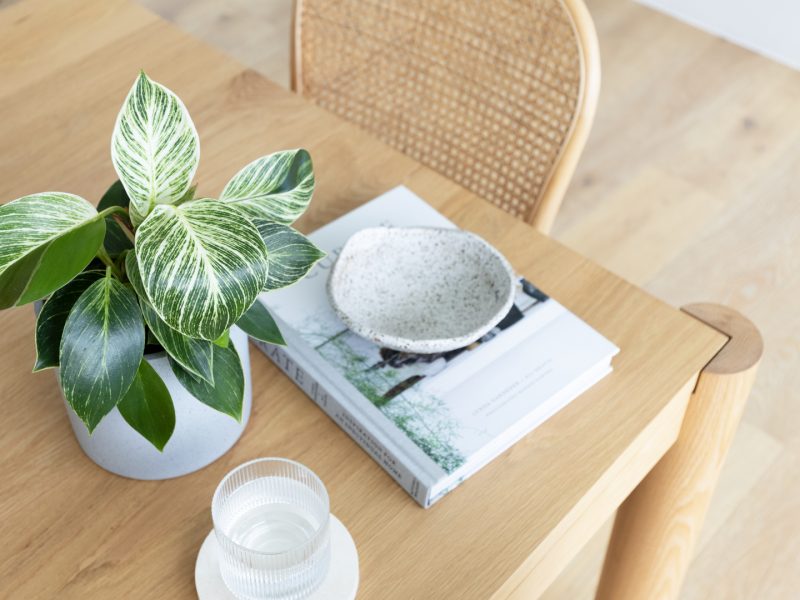
Propagating your Philodendron Birkin
You can easily propagate a Philodendron Birkin plant by taking a stem cutting. We recommend propagating in spring as the growth period is beginning. Place the cutting in water for a few weeks, replacing the water every other day.
Once roots begin to develop you can pot your cutting in fresh soil and continue with your normal Philodendron Birkin care routine. We have an entire Philodendron Birkin propagation guide to help you through the process and ensure it is a success!
Repotting your Philodendron Birkin
If not repotted frequently enough, your Philodendron Birkin will start to stunt its growth as there is nowhere else for the root system to expand to sustain larger growth. Depending on the environment, you will need to repot every 1-2 years.
If you see roots growing out of the bottom or top of the pot this is a sign it needs more room. A lack of new growth during spring and summer can also be an indication that your Birkin is rootbound and needs to be upgraded to a larger pot. However, there are other factors that may lead to stunted growth including time of year, temperature and light level so be sure to confirm this by checking the root system and other environmental factors.
When repotting you need to be sure that you don’t use a pot that is too big as this can not only cause the plant to become unstable but it can also increase the time needed for the soil to dry out which increases the risk of root rot.
Philodendron Birkin Toxicity to Humans and Pets
Philodendron Birkin plants are toxic to pets and children and digestion of any part of the plant can cause skin, mouth, tongue, throat and stomach irritation. This is because it includes a high level of calcium oxalate crystals which is toxic to ingest. The crystals are insoluble which means that they won’t dissolve in saliva but are instead sharp and can cut skin tissue.
If you, your child or your pet has come into contact with sap from the Birkin and are displaying symptoms, seek medical attention immediately.
Although rare, it can also happen that Birkin can cause some skin irritation when handled. This is why we tend to recommend wearing gloves when propagating, repotting or pruning your Birkin.
Treating and Preventing Pests
Although rare, it can sometimes happen that you find some unwanted visitors on your Birkin. This is more common if your plant has spent any time outdoors. Pests such as spider mites, scale insects and mealybugs can create real havoc with your plant’s health and can cause brown leaves, brown spots, holes in the leaves and plant death if not treated.
Make sure to give your Philodendron Birkin a regular check-up as treating a pest infestation early is the key to getting rid of it. Checking over the leaves will also help you spot other common problems early.
If you do spot pests on your Philodendron Birkin, isolate it from all other plants before starting treatment. Then remove the worst affected leaves, wash it down in the shower and treat it with neem oil.
Philodendron Birkin Common Problems
Why does my Philodendron Birkin have dry leaf tips?
If you notice brown dry leaf tips on your Philodendron White Wave, it is often an indication of underwatering. Check the moisture levels in the soil and adjust your watering accordingly.
Why has my Birkin developed yellow leaves?
Yellowing leaves on your Philodendron Birkin are a sign that it has been overwatered. Replace the soil immediately if it is still waterlogged and cut down on the amount of water given each week.
Why does my Philodendron Birkin have brown spots on its leaves?
If you notice brown spots starting to develop on the leaves of your Philodendron Birkin, it is often a sign of dry air. Birkin plants need quite high humidity as they are native to the tropics. You can find out more about increasing the humidity for your houseplants in our humidity guide.
Why is my Philodendron Birkin leggy?
The most common reason why Philodendron Birkin has become leggy is that it’s not receiving enough sunlight. This can be quite common during winter and isn’t due to anything you’ve done wrong but just because the light level drops.
To avoid further leggy growth on your Philodendron White Wave, move your plant to a slightly sunnier area of your home. You may also need to supplement the light with a grow light over winter to avoid leggy stems.
Although the leggy growth won’t hurt your plant, you may choose to remove it.
Why has my Philodendron Birkin lost its variegation?
If the new leaves on your Philodendron Birkin have turned greener and have lost the white variegation, then it’s likely due to your plant not receiving enough sunlight. This can be quite common over winter where your plant will receive a lot less natural sunlight.
Try to move your plant close to the window during winter to maximise on any extra sunlight. Just remember to move them around in spring so that you aren’t exposing your plant to lots of intense summer direct sun.
If there isn’t a sunnier spot for your plant, then supplement the light levels using an LED grow light and you should start to see more variegation on the next leaves.



